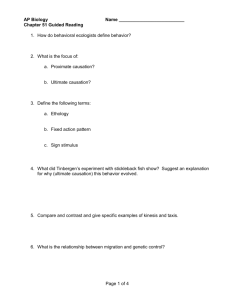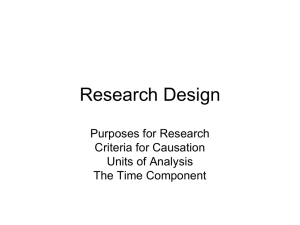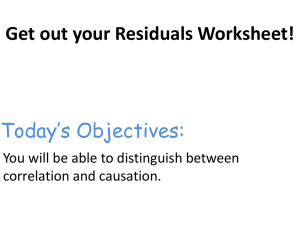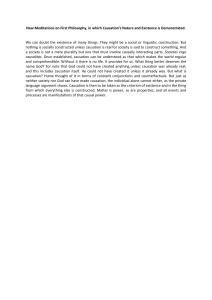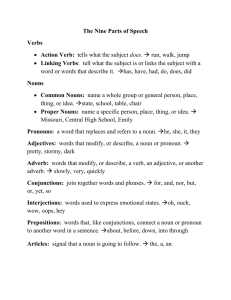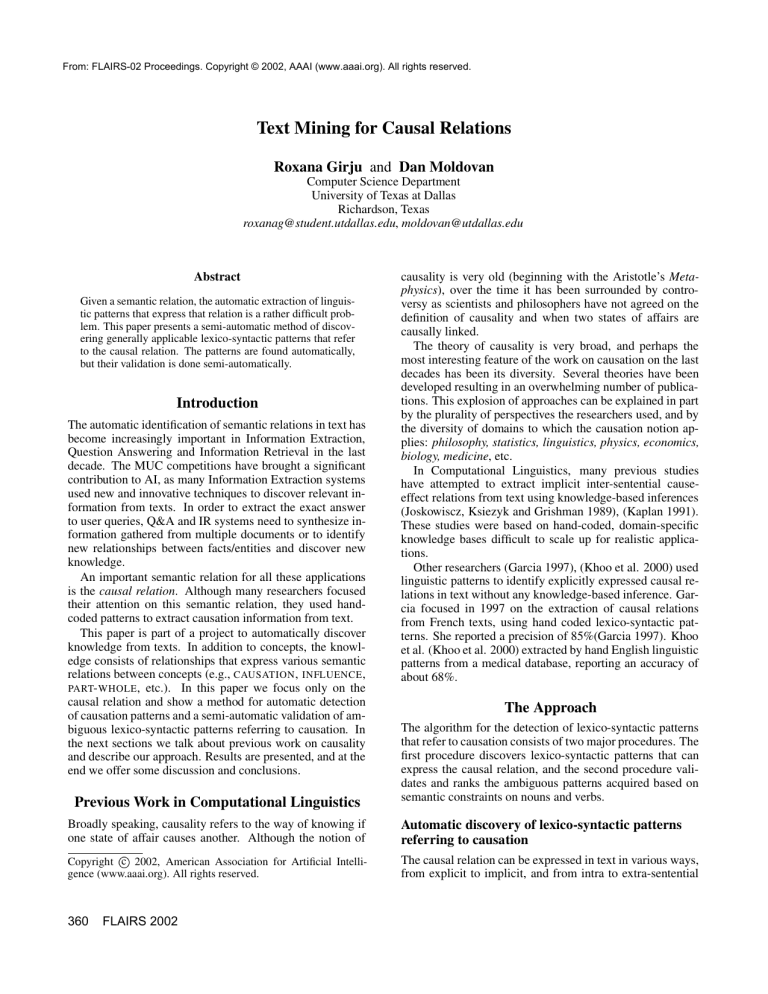
From: FLAIRS-02 Proceedings. Copyright © 2002, AAAI (www.aaai.org). All rights reserved.
Text Mining for Causal Relations
Roxana Girju and Dan Moldovan
Computer Science Department
University of Texas at Dallas
Richardson, Texas
roxanag@student.utdallas.edu, moldovan@utdallas.edu
Abstract
Given a semantic relation, the automatic extraction of linguistic patterns that express that relation is a rather difficult problem. This paper presents a semi-automatic method of discovering generally applicable lexico-syntactic patterns that refer
to the causal relation. The patterns are found automatically,
but their validation is done semi-automatically.
Introduction
The automatic identification of semantic relations in text has
become increasingly important in Information Extraction,
Question Answering and Information Retrieval in the last
decade. The MUC competitions have brought a significant
contribution to AI, as many Information Extraction systems
used new and innovative techniques to discover relevant information from texts. In order to extract the exact answer
to user queries, Q&A and IR systems need to synthesize information gathered from multiple documents or to identify
new relationships between facts/entities and discover new
knowledge.
An important semantic relation for all these applications
is the causal relation. Although many researchers focused
their attention on this semantic relation, they used handcoded patterns to extract causation information from text.
This paper is part of a project to automatically discover
knowledge from texts. In addition to concepts, the knowledge consists of relationships that express various semantic
relations between concepts (e.g., CAUSATION , INFLUENCE ,
PART- WHOLE , etc.). In this paper we focus only on the
causal relation and show a method for automatic detection
of causation patterns and a semi-automatic validation of ambiguous lexico-syntactic patterns referring to causation. In
the next sections we talk about previous work on causality
and describe our approach. Results are presented, and at the
end we offer some discussion and conclusions.
Previous Work in Computational Linguistics
causality is very old (beginning with the Aristotle’s Metaphysics), over the time it has been surrounded by controversy as scientists and philosophers have not agreed on the
definition of causality and when two states of affairs are
causally linked.
The theory of causality is very broad, and perhaps the
most interesting feature of the work on causation on the last
decades has been its diversity. Several theories have been
developed resulting in an overwhelming number of publications. This explosion of approaches can be explained in part
by the plurality of perspectives the researchers used, and by
the diversity of domains to which the causation notion applies: philosophy, statistics, linguistics, physics, economics,
biology, medicine, etc.
In Computational Linguistics, many previous studies
have attempted to extract implicit inter-sentential causeeffect relations from text using knowledge-based inferences
(Joskowiscz, Ksiezyk and Grishman 1989), (Kaplan 1991).
These studies were based on hand-coded, domain-specific
knowledge bases difficult to scale up for realistic applications.
Other researchers (Garcia 1997), (Khoo et al. 2000) used
linguistic patterns to identify explicitly expressed causal relations in text without any knowledge-based inference. Garcia focused in 1997 on the extraction of causal relations
from French texts, using hand coded lexico-syntactic patterns. She reported a precision of 85%(Garcia 1997). Khoo
et al. (Khoo et al. 2000) extracted by hand English linguistic
patterns from a medical database, reporting an accuracy of
about 68%.
The Approach
The algorithm for the detection of lexico-syntactic patterns
that refer to causation consists of two major procedures. The
first procedure discovers lexico-syntactic patterns that can
express the causal relation, and the second procedure validates and ranks the ambiguous patterns acquired based on
semantic constraints on nouns and verbs.
Broadly speaking, causality refers to the way of knowing if
one state of affair causes another. Although the notion of
Automatic discovery of lexico-syntactic patterns
referring to causation
Copyright c 2002, American Association for Artificial Intelligence (www.aaai.org). All rights reserved.
The causal relation can be expressed in text in various ways,
from explicit to implicit, and from intra to extra-sentential
360
FLAIRS 2002
patterns. One of the most frequent explicit intra-sentential
NP2 .
pattern that can express causation is NP1
According to two Russian linguists (Nedjalkov and Silnickij 1973) who made multilingual causation studies, the
causation verbs can be classified in the following categories:
1. Simple causatives - the linking verb refers only to the
causal link, most of the time being synonymous with
cause. For example,
Earthquakes generate tidal waves.
Here the verb “generate” is synonymous with “cause”.
2. Resultative causatives - the linking verb refers to the
causal link plus a part of the resulting situation. E.g.: kill
(cause to die), melt, dry, break, drop, etc.
3. Instrumental causatives - they express a part of the causing event as well as the result. E.g., poison (killing by
poisoning), hang, punch, clean, etc.
In this paper we focus on explicit intra-sentential
syntactic-patterns of the form NP1
NP2 , where the
verb is a simple causative.
In order to catch the most frequently used lexico-syntactic
patterns referring to causation, we used a modified version
of the Hearst’s procedure (Hearst 1998), as described below:
Procedure 1. Discovery of lexico-syntactic patterns:
1. Pick a semantic relation R (e.g., CAUSATION)
2. Pick a pair of noun phrases ,
among which R holds.
In order to get as many causation patterns as possible, we repeated step 2 for a list of noun phrases
extracted from WordNet 1.7. WordNet(Miller 1995)
contains 17 semantic relations: IS - A, reverse IS A , MERONYMY / HOLONYMY , ENTAIL , CAUSE - TO , ATTRIBUTE , PERTAINYMY, ANTONYMY, SYNSET ( SYN ONYMY ), etc. The CAUSE - TO relation is a transitive relation between verb synsets. For example, in WordNet
the second sense of the verb develop is causes to grow.
Given the fact that almost all these verbs have nominalizations, it is easy to find noun concepts among which the
WordNet causal relations hold. Although WordNet contains numerous causal relationships between nouns that
are always true, they are not directly mentioned. One way
to determine such relationships is to look for all patterns
that occur between a noun entry and another noun in the corresponding gloss definition. One such example is the causal relationship between
bonyness and starvation .
The gloss of bonyness (#1/1) is (extreme leanness (usually caused by starvation or disease)).
WordNet 1.7 contains 429 such relations linking nouns
from different domains, the most frequent being medicine
(about 58.28%).
3. Extract lexico-syntactic patterns that link the two selected
noun phrases by searching a collection of texts.
For each pair of causation nouns determined above,
search the Internet or any other collection of documents.
Retain only the sentences containing the pair. From these
sentences, determine automatically all the patterns NP1
verb/verb expression NP2 , where NP1 - NP2 is the pair
considered.
The result is a list of verbs/verbal expressions that refer
to causation. Some of these verbs are always referring to
causation, but most of them are ambiguous, in the sense
that they express a causation relation only in a particular
context and only between specific pairs of nouns. For example, NP1 causes NP2 refers always to causation,
but this is not true for NP1 produces NP2 . In most
cases, the verb produce has the sense of manufacture, but
in some particular contexts it refers to causation.
In her procedure, Hirst selects the patterns by hand and
applies them to text without making any semantic filtering
on the relationships obtained. In this approach, the acquisition of linguistic patterns is done automatically, as the
pattern is predefined (NP1 verb NP2). As is described in
the next subsection, the relationships are disambiguated
and ranked and only those referring to causation are retained.
Validation of causation patterns and ranking of
causation relationships
Because the exact disambiguation of the verb sense is often
very difficult, we try to validate the lexico-syntactic patterns
using a coarse-grain approach. The approach consists of detecting the constraints necessary and sufficient on nouns and
verb for the pattern NP1
NP2 such that the lexicosyntactic pattern indicates a causal relationship.
and
Semantic constraints on nouns
The basic idea we employ here is that only some categories of noun phrases can be associated with a causation
link. According to the philosophy researcher Jaegwon Kim
(Kim 1993), any discussion of causation implies an ontological framework of entities among which causal relations are
to hold, and also ”an accompanying logical and semantical
framework in which these entities can be talked about”. He
argues that the entities that represent either causes or effects
are often events, but also conditions, states, phenomena, processes, and sometimes even facts, and that coherent causal
talk is possible only within a coherent ontological framework of such states of affairs.
In a relationship of the form NP1
NP2 , the nouns
NP1 (cause noun) and NP2 (effect noun), can express explicit or implicit states of affairs. The following four situations can occur:
1. cause noun and effect noun are explicit states of affairs.
e.g: Earthquakes cause tidal waves.
2. effect noun expresses an explicit state of affair, and
cause noun an implicit one.
e.g: John caused the disturbance.
3. cause noun shows an explicit state of affair, and effect noun an implicit one.
e.g: Sometimes rain can cause you bad days.
4. cause noun and effect noun are implicit states of affairs.
e.g: John caused her really bad days.
FLAIRS 2002
361
Examples 2 and 4 denote a causal relationship as the verb
caused indicates, but the relation is not explicit. John cannot
cause directly a psychological state (e.g., the disturbance),
but the action John undertook caused it. In this paper we
focus only on the situations 1 and 2, as they are the most
frequently used in texts.
Given this approach the system selects automatically the
causation classes with the following procedure:
S TEP 1. Semantic constraints on
For each noun occupying the EFFECT position in the causation pairs detected in step 1 of Procedure 1, select as causation class the most general subsumer in WordNet for that
given sense. For example, the most general subsumer of the
word excitement (#1/4) in WordNet is psychological feature.
In WordNet, all the EFFECT nouns in the causation pairs represent entities that express explicit states of affairs.
At the end of this step, the system detected the following
causation classes: human action, phenomenon, state, psychological feature, and event. Our assumption is that these
classes represent causation categories, and anything else that
is not in this list refers to noncausation.
S TEP 2.Semantic constraints on
We noticed from the corpus created in Procedure 1 that
metonymy occurs with high frequency in causal relationships, but mostly on the CAUSE position, and quite rarely
on the EFFECT position.
This observation is also supported by the large number
nouns on the cause posiof classes obtained for the
tion with the procedure describe above. This shows that the
CAUSE nouns can be represented by almost any noun. Thus,
we use here only a soft constraint which would help validate the relationships in some special cases explained later
in section 4:
soft constraint on CAUSE: the noun should have as subsumer
the concept causal agent in WordNet. For example, the second most general subsumer of the word drug in WordNet is
causal agent.
Semantic constraints on verbs
We ranked the verbs/verb expressions extracted in step 3 of
Procedure 1 based on their ambiguity and frequency levels
in WordNet. In WordNet, verbs are represented in synsets,
which are lists of synonyms for that verb, and each verb can
have multiple senses. For a given verb, in WordNet 1.7 the
senses are ranked based on the number of times each sense
occurs in the semantically tagged corpus used by the WordNet lexicographers. Based on the observation on WordNet
of the extracted verbs, we considered the following categories of constraints along with their thresholds:
4. high frequency: if (the frequency for that particular sense
the sum of the frequency of all other senses) or (the
frequency for that particular sense
30)
Table 1 shows a part of the verbs extracted with Procedure
1 ranked according with the constraints defined above.
For example, the verb make is ranked at the end because it
is highly ambiguous (there are 49 senses in WordNet 1.7 for
this verb) and occurs with high frequency (79 occurrences
in WordNet tagged corpus). Thus, the sentence “Greenspan
makes a recession” is highly ambiguous as it can be interpreted in two ways: either (1) as a causal relation if recession has the sense #1/4 (the state of the economy declines),
or (2) as noncausative relation if recession has the sense #2/4
(a small concavity).
The Algorithm
The algorithm for the validation and ranking of the causal
relationships is an iterative procedure in which a step is followed if the condition in the previous step was not satisfied.
In this algorithm we consider as
and
only the
head noun of the noun phrases extracted, as it occurs in
WordNet (e.g, for the noun phrase “giant tidal wave”, tidal
wave is automatically selected).
Procedure 2.
Step 1.
If the EFFECT and CAUSE head nouns are monosemous
and they belong to one of the causation classes, or are
polisemous and all their senses belong to the causation
classes, then classify the relationship as causation of rank 1.
For example, “Hitler’s invasion of Poland provoked the
Second World War”.
Here, both invasion and Second World War have all their
senses in causation classes, so even if the verb provoke is
ambiguous, the relationship is detected as causation.
Step 2.
If the EFFECT head noun is monosemous and it belongs
to one of the causation classes, or is polisemous and all
its senses belong to the causation classes, then classify the
relationship as causation of rank 2.
For example, “In 1958, it was Bleustein-Blanchet who
sparked a controversy when he opened Le Drugstore, the
American-inspired combination pharmacy, all-hours restaurant and gift store that now has branches at both ends of the
avenue”. Here, the causal relation is obvious as controversy
is monosemous and its sense has the semantic class human
action.
2. high ambiguity: if the number of senses for the verb considered
Step 3.
If the EFFECT is represented by an enumeration of noun
phrases and the head noun of at least one of them has all the
senses in one of the causation classes, than the others also
refer to causation in that context. Classify the relationship
as causation of rank 3.
3. low frequency: - if (the frequency for that particular sense
the sum of the frequency of all other senses) or (the
frequency for that particular sense 30)
For example, in the sentence “Fed will induce a recession
and unemployment” the effect unemployment is monosemous and belongs to the causation class state. Thus, the
1. low ambiguity: - if the number of senses for the verb considered
362
FLAIRS 2002
Low ambiguity
High frequency
Low ambiguity
Low frequency
High ambiguity
Low frequency
High ambiguity
High frequency
induce
give rise (to)
produce
generate
effect
bring about
provoke
arouse
elicit
lead (to)
trigger
derive (from)
associate (with)
relate (to)
link (to)
stem (from)
originate
bring forth
lead up
trigger off
bring on
result (from)
stir up
entail
contribute to
set up
trigger off
commence
set off
set in motion
bring on
conduce to
educe
originate in
lead off
spark
spark off
evoke
link up
implicate (in)
activate
actuate
kindle
fire up
stimulate
call forth
unleash
effectuate
kick up
give birth (to)
call down
put forward
create
launch
develop
bring
start
make
begin
rise
Table 1: Ambiguous causation verbs ranked based on ambiguity and frequency. The ambiguity increases from the left most
column to the right.
effect noun recession is disambiguated and its interpretation
as sense #2 niche, corner is eliminated.
Step 4.
If the noun phrase representing the EFFECT is ambiguous (at
least one of its senses does not belong to a causation class)
and the CAUSE respects the soft constraint defined in the
previous section, then classify the relationship as causation
of rank 4.
For example, in the sentence “The drugs induce the
growth of muscle tones”, the head noun growth has two
senses (#4/7 and #7/7) that are in two noncausation classes
(e.g., group, grouping , and respectively entity ). In this
case, the noun drugs disambiguates the relationship as it is
monosemous and has causal agent as one of its hypernyms.
Step 5.
At this point, the remaining nouns representing the CAUSE
and EFFECT are ambiguous and the only possibility of
disambiguation comes from the restrictions imposed on the
verbs.
For example, in the sentence “The issue gives rise to a
big concern’”, both the CAUSE and EFFECT are ambiguous.
The noun issue can be “an important question that is in dis-
pute and must be settled” (psychological feature, cf. WordNet), or “one of a series published periodically” (entity, cf.
WordNet). The noun concern can refer to an anxious feeling (psychological feature, cf. WordNet), or commercial or
industrial enterprise (group, grouping). In this case the relationship is considered causation only because the verb give
rise is one of the less ambiguous and highly frequent verbs
considered.
For all the remaining relationships, classify them based
on the verbs’ ranking shown in Figure 1.
Results
In this section we show the results obtained by the validation and ranking algorithm. For this experiment we used the
TREC-9 (TREC-9 2000) collection of texts which contains
3GB of news articles from Wall Street Journal, Financial
Times, Financial Report, etc. Using the causation verbs obtained in step 3 of Procedure 1, the system formed queries
and searched the TREC collection. This way, for each verb
there were selected 50 sentences that contained it. The new
corpus thus formed (3,000 sentences) was part-of-speech
tagged and parsed. For each head of the noun phrases in the
CAUSE and EFFECT positions, the system determined automatically the most general subsumer for each sense. The al-
FLAIRS 2002
363
gorithm presented in section 4 was implemented and the sysverb
tem gave as output 1,321 causal relationships
, ranked by generality.
The results were validated by comparison with human annotation. We asked two subjects, other than the authors, to
rank a list of 300 relationships from which only 230 were
referring to causation, as detected by our algorithm. Out of
the 300 relationships the subjects selected as causal relationships only 151 on average (Table 2). In what concerns the
rating of the causal relationships, it differed from one subject to another with about 36%, and from the system’s output
by 48%.
The accuracy obtained by our system in comparison with
the average of two human annotations was 65.6%.
System
Rank 1
Rank 2
Rank 3
Rank 4
Total
37
73
28
92
230
Human
annotator 1
Human
annotator 2
162 (70.43%)
140 (60.87%)
Table 2: Comparison with human annotation and accuracy
obtained for the 230 causal relationships (the percentages in
parentheses represent the accuracy obtained by the system
reported to the human annotator).
Discussion and Conclusions
The approach presented in this paper for the detection and
validation of causation patterns is a novel one. Even if the
method is semi-automatic, it brings considerable improvement in time and user work compared with other previous
attempts (Garcia 1997), (Khoo et al. 2000). Khoo at al.
obtained a better accuracy, but they restricted their text corpus to a medical database and did not handle the ambiguity
problem.
Our method discovers automatically generally applicable
lexico-syntactic patterns referring to causation and disambiguates the causal relationships obtained from the patterns
application on text.
We intend to extend the analysis to other causation patterns and devise a general algorithm for the detection and
especially for the validation of causation patterns. We also
consider to test the method for other semantic relations like
PART- OF and INFLUENCE .
References
Marti Hearst. Automated Discovery of WordNet Relations. In
WordNet: An Electronic Lexical Database and Some of its Applications, editor Fellbaum, C., MIT Press, 1998.
D. Garcia. COATIS, an NLP system to locate expressions of actions connected by causality links. In Knowledge Acquisition,
Modeling and Mangement, Proceedings of the Tenth European
Workshop, EKAW ’97, pages 347-352.
L. Joskowiscz, T. Ksiezyk and R. Grishman. Deep domain models
for discourse anaysis. In The Annual AI Systems in Government
Conference, Silver Spring MD, pages 195-200.
364
FLAIRS 2002
R.M. Kaplan, and G. Berry-Rogghe. Knowledge-based acquisition of causal relationships in text. In Knowledge Acquisition,
3(3), 317-337.
Christopher Khoo, Syin Chan and Yun Niu. Extracting Causal
Knowledge from a Medical Database Using Graphical Patterns
In Proceedings of 38th Annual Meeting of the ACL, Hong Kong,
2000, pages 336-343.
Jaegwon Kim. Causes and Events: Mackie on Causation. In
Causation, Oxford Readings in Philosophy, ed. Ernest Sosa, and
Michael Tooley, Oxford University Press, 1993.
G.A. Miller. WordNet: A Lexical Database. Communication of
the ACM, vol 38: No11, pages 39–41, 1995.
V.P. Nedjalkov and G. Silnickij. The topology of causative constructions. In Folia Linguistica (6), 1973, pages 273-290 (german
translation)
Text REtrieval Conference. http://trec.nist.gov 2000

